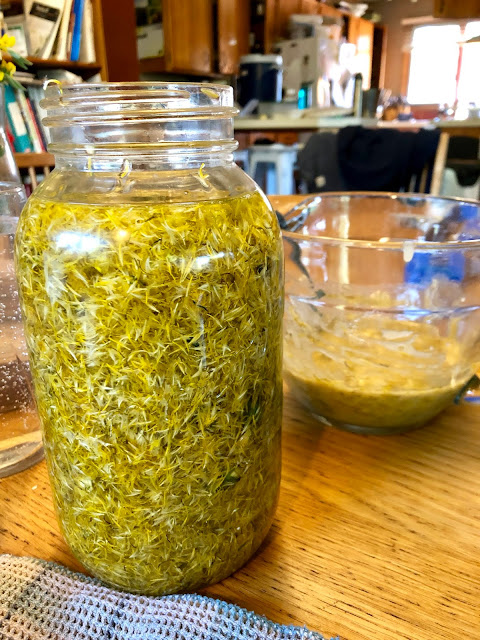Dandelion Love
How this Simple Flower can Benefit us all!
 |
| My kids are excellent dandelion harvest helpers! |
Dandelion - Taraxacum officinale
In Latin taraxos means "disorder" and achos means "remedy. Officinale signifies that it is an official medicinal plan.
Dandelions. Loved by children and dismissed or despised by adults everywhere. Bunched into quick-wilting bouquets for mama, fluff blown away by the dreamy individuals, but mowed, weeded, or sprayed by the grownups. And if you hate them, you have a right to hate how virile and prolific they are. A single plant can produce 5000 seeds - or more - in one year. That alone is one of the reasons they are one of the most widespread vascular plant species in the world.
However, the common dandelion has been prized all over the world as food and medicine since recorded history, and probably before. And another plug - besides being an early bee food, they also restore nutrients (like nitrogen) to the soil, making them beneficial in your yard and garden. Who knew?
Medicinally, dandelions are a diruetic, a blood/liver/kidney cleaner. They are anti-inflammatory, and are used by herbalists to treat digestive disorders. They help your body increase the production of hydrochloric acid in the stomach which in turn helps you to better absorb nutrients like calcium. Some studies indicate that the root can lower cholesterol and high blood pressure, which is why they are currently seeing a surge in popularity as a coffee substitute (here's a recipe!). And while I've never tried it, I've read that the latexy sap inside the stem can be effective at ridding an individual of warts. Because our skin is so closely linked to our kidney and liver function, dandelion is also very beneficial to our skin, helping with eczema, acne, etc. This dandelion coconut oil is incredibly nourishing to dry or eczema-ridden skin. Adding some burdock root decoction helps even more, but that's another post. I've got some oil on the go right now, and will be making this salve with it, soon.
There are so many uses of dandelion. Making a simple tea of the leaves will help to eliminate excess fluids/water retention, and supplies you with all those vitamins and minerals. It's safe for all ages, levels of health, and for pregnant women as well. I like to fill a pot with dandelion leaves and nettle leaves (which are excellent for relieving one of hayfever allery symptoms and are high in vitamins and minerals), cover with water, and simmer for 20 minutes, covered. Remove from heat (refrigerate) and allow to steep overnight. I strain and then sip on when I think of it. You can make it taste alright with some honey, but I don't mind shooting a bit straight up. Here's a slightly more complex version that looks amazingly tasty!
When it comes to harvesting wild plants, I don't look a gift horse in the mouth. Dandelions are up before my garden greens are, so a wild salad that includes them is often the first real taste of spring. When I head out to the garden, I take a bowl or basket with me so I can glean out any "weeds" that are good for eating.
We started by throwing the leaves into salads, or sautéing with an egg dish or with mushrooms to have with our steak. I throw the chopped leaves into risotto or sautéed veggies. They're lovely and bitter. If I do dandelion greens solo, without anything to mask the bitterness, then I need to be creative with other flavours to balance it out. Creamed with garlic is pretty nice, a bit like a stronger spinach or chard.
A few more ideas:
- I made this quiche last week (though I did it crustless), and it was really good!
- On my list to try - dandelion 'capers'! The pickled buds may be strikingly similar, and I want to try!
- These shortbread cookies. I will use some of the frozen blossoms that we've thrown in the freezer for later.
- These paleo cupcakes! They look so good. Cute presentation, too.... though that wouldn't last long. Dandelions wilt FAST.
- Dandelion Honey Butter. I made the honey, now to whip it with some butter..... yummmmmmmmm.
- I have to add the dandelion crowns recipe from Forager Chef. These are SO GOOD! If you like artichoke hearts, you will love dandelion crowns.
- Go out earlier in the day, before they start to close up.
- Only pick as many as you're going to deal with right away. You can either pull the blossoms from the flower head (discarding the bitter green) or use the whole thing for something like a vinegar or oil infusion (literally just put the blossoms or flower heads in a jar with the oil or vinegar of your choice, and shake every couple of days for 2-4 weeks. Strain and store).
- The blossoms are sweet, so for baking or sweet oil, JUST use the blossoms.
- Blossoms will keep for 6 months in your freezer. If you go out and just get a few each day, you can freeze them for later and accumulate enough for fun recipes. It takes a while to pluck the blossoms from the heads, just so's you know. Don't be like me and pick a huge basket full and expect yourself to deal with all of them.
You can use the full blossom head for infused vinegar or infused oils for salves. Use the blossoms only for things like infused honey, oil for salad dressing, and for baking. FREEZE them fresh, before they start to "fluff".
No recipes for you today - I linked so many things, you've got a lot of leads!
 |
| This is Helen's dandelion blossom olive oil. It will be strained and used for drizzles and dressings. A lovely, light floral taste! |





Comments
Post a Comment